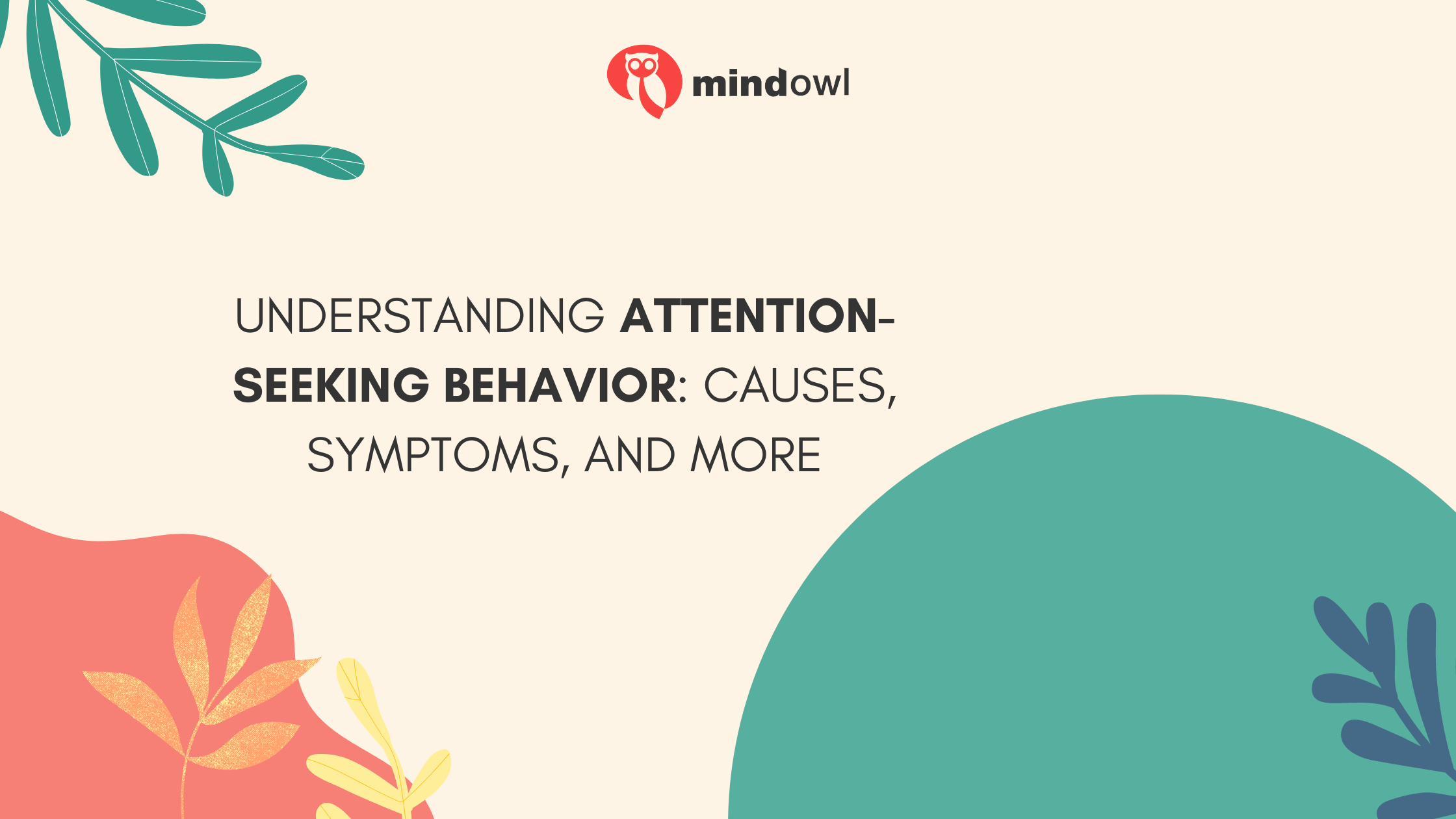Have you ever noticed someone going out of their way to be the centre of attention? Maybe it’s a friend who always has an exaggerated story to tell, or your child acting up when they feel ignored.
Understanding why people seek attention can sometimes feel like solving a puzzle. One important fact to keep in mind is that seeking attention isn’t just about wanting to be in the spotlight; often, it’s tied to deeper issues like low self-esteem or feelings of insignificance.
This article will help you decode the complexities behind attention-seeking behaviour. We’ll explore its causes, how it manifests differently in adults and children, and its connection with mental health conditions. Plus, we’ll offer practical strategies for managing these behaviours effectively.
Key Takeaways
- People seek attention in various ways, such as fishing for compliments and acting dramatically. This behaviour often stems from deep emotional needs like low self-esteem, loneliness, or past neglect.
- Attention-seeking actions differ between adults and children. Adults may seek validation through controversy or compliments, while children act out to communicate their need for acknowledgement and love.
- Conditions like ADHD and autism can influence attention-seeking behaviour in kids. They may act disruptively as a way to express themselves and connect with others.
- Mental health disorders, including Histrionic Personality Disorder, Borderline Personality Disorder, and Narcissistic Personality Disorder, are linked with attention-seeking behaviour. Each has its unique traits but commonly involves a craving for attention.
- Managing attention-seeking behaviour involves ignoring it when appropriate, providing positive reinforcement for desired behaviours, setting clear boundaries, encouraging self-awareness, teaching socially acceptable ways of seeking connection, and sometimes seeking professional help if the issue persists.

Understanding Attention-Seeking Behaviour
Understanding attention-seeking behaviour involves recognising the various ways individuals seek validation and affirmation. It also entails identifying triggers driving attention-seeking behaviours in adults and children.
Common Examples
People often seek attention in various ways, some noticeable and others more subtle. Fishing for compliments, seeking validation, being controversial to provoke reactions, and raising one’s voice are just a few examples.
Individuals might also feign inability or embellish stories to attract more eyes on them. These behaviours can stem from different causes ranging from loneliness to jealousy.
Adults and children show these behaviours differently. Adults might stir controversy or fish for compliments as part of their interaction with peers or within social contexts. Children could exhibit similar actions but with less understanding of the implications.
They may yell, whine, or act out dramatically in their quest for attention—behaviours that signal a need for reassurance or affirmation from those around them.
Causes and Triggers
Attention-seeking behaviour often comes from deep emotional needs not being met. Some people might feel invisible or ignored and crave the spotlight to validate their existence. They may have faced neglect or lack of love during their childhood, driving them to seek any form of attention in adulthood, be it positive or negative.
This craving can lead to patterns where they constantly seek validation through others’ approval or admiration.
Low self-esteem and jealousy also play crucial roles as triggers for attention-seeking actions. Individuals with poor self-image may overcompensate by becoming the center of attention, hoping this will make them feel valued and accepted.
On another note, jealousy can push someone towards behaving disruptively just to steal back the spotlight they believe they deserve. Such behaviours are not only a call for help but also a sign that underlying issues like loneliness or personality disorders may be at play, further complicating their interpersonal relationships and sense of security.

Attention-seeking behaviour in Adults and Children
Adults and children exhibit attention-seeking behaviour for various reasons. Adults may do this due to jealousy, low self-esteem, loneliness, or underlying personality disorders. They crave being the centre of attention and often seek external validation to feel valued.
Their actions serve as a loud call for others’ notice and care.
Children show attention-seeking behaviour as their unique way of expressing needs. Unlike adults, kids might not understand how to verbalise their feelings of being overlooked or insignificant.
They act out with the hope that someone will see them and respond to their silent pleas for acknowledgement and love. Both groups use these behaviours in attempts to connect with those around them and fill the emotional gaps they experience.
The link between Attention-Seeking Behaviour and Neurodevelopmental Conditions
Kids with neurodevelopmental disorders, like autism, often find attention-seeking behaviour disruptive. They might act out to get the spotlight or struggle to share it. These actions aren’t just about wanting to be seen; they’re a way for these children to communicate and feel understood.
Neurodevelopmental conditions can make traditional forms of expression tough. So, kids use what they’ve got — actions that grab our attention.
Attention-deficit/hyperactivity disorder (ADHD) also links closely with seeking the limelight. Those with ADHD may display impulsive behaviours or have trouble keeping their need for stimulation in check.
It’s not just about being noticed; it’s an attempt to manage how they interact with the world around them. This drive for external validation reflects deeper challenges faced by individuals navigating life with ADHD or other similar conditions.
Connection to Mental Health Disorders
People with attention-seeking behaviour may exhibit traits associated with mental health disorders, including Histrionic Personality Disorder, Borderline Personality Disorder, and Narcissistic Personality Disorder.
Histrionic Personality Disorder
Histrionic Personality Disorder (HPD) stands out for its patterns of attention-seeking behaviours and a deep need for reassurance. Individuals with this disorder often show intense, unstable emotions and have a distorted view of themselves.
This condition is long-lasting and usually starts in early adulthood, impacting the affected person’s social interactions severely.
Those diagnosed with HPD find it hard when others get more attention than they do. Their actions are driven by an excessive desire to be noticed, which can strain relationships. The American Psychiatric Association highlights that these behaviours are not just occasional but persist over time, making everyday functioning challenging for someone with HPD.
Borderline Personality Disorder
Borderline Personality Disorder (BPD) deeply affects a person’s control over their emotions. This disorder makes it hard for someone to feel good about themselves and others, causing painful emotional states, trouble in relationships, and sometimes self-harm.
People with BPD find their feelings towards themselves and those around them can change drastically, leading to intense and unstable relationships.
About 1-4% of people will develop BPD. It’s more than just seeking attention—it involves constant emotional turmoil that challenges how one manages feelings day-to-day. Understanding BPD is crucial for getting the right support and treatment options.
Narcissistic Personality Disorder
Narcissistic Personality Disorder (NPD) leads people to seek approval, admiration, or attention from others. This condition characterises itself through patterns of grandiosity, a constant need for praise, and a pronounced lack of empathy towards others.
Symptoms include impulsive actions, mood swings that can appear volatile, and behaviours aimed at becoming the centre of attention.
Research shows those with NPD often face other mental health challenges like anxiety and depression. They might also struggle with eating disorders or additional personality disorders. Neuroscience findings suggest that individuals displaying grandiose narcissism react strongly to threats against their ego or stress situations.

Identifying Attention-Seeking Behaviour
Identifying Attention-Seeking Behaviour in Adults
- Look for frequent and exaggerated stories or claims about personal achievements, experiences, or relationships.
- Pay attention to seeking admiration and validation from others excessively and often.
- Notice if the person constantly seeks to be the centre of attention in social situations and conversations.
- Be aware of sudden mood shifts or dramatic behaviour when not receiving the desired attention.
- Recognise a pattern of using physical appearance or dress to gain attention.
- Observe if the individual consistently interrupts or dominates conversations.
Identifying Attention-Seeking Behaviour in Children
- Look for excessive seeking of attention from adults or peers.
- Observe constant interrupting of conversations to steer attention towards themselves.
- Notice frequent untruthful or exaggerated stories to gain attention.
- Pay attention to disruptive behaviours, such as tantrums, when not the center of attention.
- Be aware of constantly seeking reassurance and praise from others.
- Watch for trouble in sharing or taking turns due to craving constant attention.
- Note if a child exhibits risky behaviours as a means to draw attention.
- Identify repeated physical complaints without an apparent cause.
- Notice if a child uses provocative behaviour or language that garners attention.
Remember that addressing these signs early can prevent further negative implications on a child’s development and well-being.
Strategies for Managing Attention-Seeking Behaviour
Here are strategies to manage attention-seeking behaviour:
- Ignore the behavior when it’s safe to do so, without reinforcing it.
- Provide positive attention for desired behaviours through praise or rewards.
- Set clear boundaries and consequences for inappropriate attention-seeking actions.
- Encourage self-awareness and building confidence in seeking appropriate attention.
- Teach alternative, socially acceptable ways to seek attention and connection.
- Seek professional help if the behaviour persists or escalates despite interventions.
- Address underlying emotional or developmental needs through proactive support and understanding.
When to Seek Professional Help
Seek professional support to address the underlying causes of attention-seeking behaviour in adults. It is important, especially in cases of Attention-seeking Seeking Personality Disorder and other severe instances.
Similarly, professional help plays a crucial role in understanding and managing attention-seeking behaviour in children, particularly when it presents challenges that may require expert intervention.
Conclusion
Understanding attention-seeking behaviour is crucial to effectively address it. Whether in adults or children, recognising the underlying causes and identifying the signs are essential for managing this behaviour.
Individuals can develop healthier ways of seeking attention by taking steps to address the root issues and providing positive reinforcement. Seeking professional help when necessary is equally important to provide support and guidance for individuals experiencing attention-seeking behaviour.
FAQs
1. What exactly is attention-seeking behaviour?
Attention-seeking behaviour might seem like someone simply wanting to become the centre of attention. However, it can be a sign of a mental health condition, such as disorder and narcissistic personality disorder. People may seek negative or positive attention for various reasons.
2. Can seeking attention be a sign of something more serious?
Yes, indeed! Seeking lots of attention can sometimes point to underlying issues. It’s found that needing constant reinforcement might indicate conditions listed in the DSM-5—like antisocial personality disorder or even just a cry for help when feeling lost.
3. Why do some people crave negative attention?
It sounds counterintuitive, right? But here’s the thing—negative attention still counts as receiving attention. For some individuals, any form of acknowledgement fulfils their need for validation and self-presentation—even if it’s not all positive.
4. How can I tell if someone’s behaviour is genuinely seeking help or just for show?
Identifying genuine cries for help versus mere self-centred actions can be tricky but crucial. A person truly needing support often asks for attention subtly and values intimate relationships over public spectacle; meanwhile, an “attention seeker” may present exaggerated behaviours publicly to get noticed.
5. What should I do if I think someone’s seeking unhealthy amounts of attention?
First things first—approach with kindness! Offer your support and gently encourage them to seek advice from a mental health professional who can provide expert guidance tailored to their situation.
6. Are there ways to manage my own tendencies towards seeking too much attention?
Absolutely! Self-awareness is key here—you’ve taken the first step by recognising your patterns. Next up? Reframing how you perceive validation could make all the difference. And remember, asking for help isn’t weak—it shows remarkable strength and self-control.
MindOwl Founder – My own struggles in life have led me to this path of understanding the human condition. I graduated with a bachelor’s degree in philosophy before completing a master’s degree in psychology at Regent’s University London. I then completed a postgraduate diploma in philosophical counselling before being trained in ACT (Acceptance and commitment therapy).
I’ve spent the last eight years studying the encounter of meditative practices with modern psychology.

